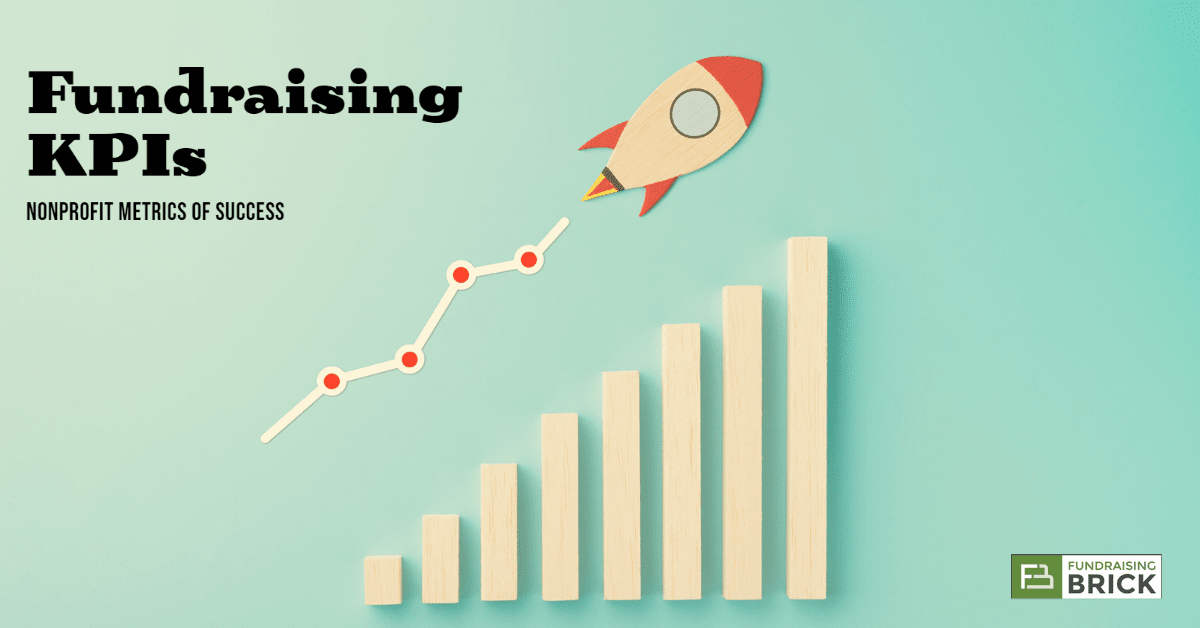
Fundraising KPIs – Nonprofit Success Metrics
You had your fundraiser. Now ask yourself the big question: Was it a success?
Do you know how to measure your fundraising success?
“Success” is a broad term, and it can mean so much more than just the total amount of money or gifts you raised for your charitable cause. Keeping in mind other factors—like email subscribers, donor growth, and return on investments—can help you decide if your current fundraising strategy is effective and how you can improve it to better align with your nonprofit’s goals.
Not sure where to start? Not a problem.
We’ve compiled a list of some of the most important KPIs, or key performance indicators, that your nonprofit organization can use to optimize your campaigns and surpass your fundraising goals.
7 Key Terms to Know – And Why They’re Important
These benchmarks will help you decide if your current strategy is sustainable over a long period of time by telling you which parts of your nonprofit fundraising campaign are working well, need to change, or could be improved upon.
1. KPI (Key Performance Indicator)
KPIs are metrics to help you understand how successful an organization or project is.
2. CTA (Calls to Action)
Anything designed to elicit an immediate response from users, such as a “Subscribe to Our Emailing List” button on a webpage.
3. CR (Conversion Rate)
CR measures how many people complete a certain action; what that action is varies by your campaign.
For example, the goal of a digital brick campaign is for people to buy laser-engraved bricks online. Your CR would be the number of people who purchased custom bricks or tiles online divided by total number of site visitors. If 20 people ordered bricks one month and you had 200 total visitors, you would have a CR of 0.1, or 10%.
4. CTR (Click-through Rate)
CTR tells you how many people click on a desired link compared to your audience. A CTR for an online advertising campaign, for instance, would be how many people click on the ad over the amount of people that saw the ad (impressions).
Say 20 people click on your ad and 100 people total see the ad. 20 / 100 = 0.2, meaning your CTR is 20%.
5. Landing Page
In online marketing, a landing page is a destination users reach after clicking through a digital space, such as an advertisement banner or email link.
6. ROI (Return-on-Investment)
ROI is one of the single-most efficient metrics to determine how profitable your current marketing efforts are. It is the ratio of net profit (profit after deducting expenses) over all investment expenses. The higher the ROI, the more profitable the investments are.
Say you made $100,000 at your last event. You spent $25,000 total in expenses for this campaign, including paying for advertising, renting venues, and more. Subtract $25,000 from $100,000 to get $75,000, your net profit. Now, divide $75,000 by $25,000 to get 3. You can convert this number into a percentage by multiplying it by 100, to get a whopping 300% ROI.
7. YOY (Year-over-Year)
YOY is a means to evaluate success over a certain time period expressed in years. It can help you determine if this year’s fundraiser was better, worse, or comparable to last year’s efforts.
Nonprofit KPIs for Fundraising (and How to Use Them Effectively)
Important fundraising metrics include the following.
1. Total Number of Donors
- Definition – The number of people that comprise your donor base.
- Why it’s important – This metric will give you a basic idea of how wide-reaching your campaign is. It gives you hard numbers that allow you to determine other KPIs, like retention rate and growth for donors.
- How to use effectively – Quickly see how many people are donating to your cause, but don’t stop there. Further segment people in this category: What is the number of new donors? Recurring donors? This segmentation will give you more specific metrics, such as donor retention rate and new donor growth rate, that you can use to better evaluate your success.
2. Donor Retention Rate
- Definition – How many donors are recurring, or donors from years past; it is the number of recurring donors in one year over the number that donated last year.
For example, if you have 260 non first-time donors this year, but 325 last year, the donor retention rate is 80% (260/325 = 0.8).
- Why it’s important – Recurring donors, or retention donors, are the single-most reliable source of donations and gifts for your nonprofit. They are also typically less expensive to persuade to donate than first-time donors.
- How to use effectively – If you see that your retention rates are declining, take action right away. You can learn more on our blog about how to find and retain recurring donors.
3. Donor Growth Rate (YOY)
- Definition – How many donors you are getting on an annual basis. It is the number of this year’s donors minus the number of last year’s donors. This number is divided by last year’s donors.
For example, say you had 200 donors this year and 150 donors last year. 200 – 150 = 50. Divide 50 by 150 to get 0.33, or a 33% donor growth rate.
- Why it’s important – More donors not only means (usually) an increase in donation amount, but also that your nonprofit organization is reaching a wider audience. That means more people can learn about your charitable cause—people that you can inspire to action!
- How to use effectively – Determine if you are attracting or losing donors. If you are losing donors, talk to your team members to discuss how future outreach initiatives can emphasize donor acquisition. If you are gaining donors, look at what parts of your campaign strategy led to that growth—and continue doing just that.
4. Donor Lifetime Value
- Definition – How much value, in recurring donation and recurring gift amounts, your donors have over a “lifetime,” or number of years you expect them to donate to your organization.
Discover this value by determining how often someone donates, how large the average donation is, and for how long you expect this person to continue donating to your cause.
For example, say someone has donated $8,000 to your organization over the past 4 years, donating once each year. $8,000 / 4 years = $2,000 per year in donations. You expect this person to donate for another 10 years, meaning you expect them to donate for a total of 14 years (original 4 years + 10 expected years). Take $2,000/year x 14 to get your donor lifetime value of $28,000.
- Why it’s important – You can better determine how “valuable” each donor is and put them into donor tiers (for example, under $500/year donation, over $500/year donation, etc.).
- How to use effectively – Once you learn which donors are more likely to give major gifts and donations and which are more likely to give smaller amounts, you can better adjust your donation appeals to them.
5. Total Donation Amount/Total Number of Gifts
- Definition – How much money or gifts you raised over a period of time or during a specific event.
- Why it’s important – The number of donations and gifts your organization received can help you quickly see at a glance if you met your goals (for example, if you achieved your $100,000 goal during your last event).
- How to use effectively – Don’t just stop at seeing if you reached this fundraiser’s goals. Use this value to determine other key metrics of success, such as average donation amount and donation growth.
6. Average Donation Amount/Average Gift Size
- Definition – The total donation amount divided by the number of donors.
- Why it’s important – Quickly tells you how much most people are willing to donate at any given time.
- How to use effectively – Use this value to calculate your ROI, donation growth ratio, and other KPIs.
- Tip – Don’t confuse “average” with “median,” because they are two separate metrics! The median donation amount is the most common amount donated to your cause. That could be quite different from your average donation, which could be skewed by a singular unusually large or small donation.
7. Donation Growth (YOY)
- Definition – The size of donations compared on an annual basis. It is the total amount of this year’s donations minus last year’s donations, which is then divided by last year’s donations.
Say 2021’s donations totaled $10,000 and 2020’s $6,000. $10,000 – $6,000 = $4,000. $4,000 / $6,000 = 0.66, or a 66% donation growth.
- Why it’s important – See if your donations are growing or shrinking at a glance.
- How to use effectively – Not every year will see growth, and that’s okay. However, continually seeing a decline in donation amounts can be alarming, as it means your fundraising efforts are slowly losing this effectiveness. Use the other KPIs in your fundraising toolkit to pinpoint where your marketing efforts are falling short, so you can revitalize your campaigns.
8. Donation CRs by Channel
- Definition – This metric tracks how many donations you receive per channel. Channels are the methods people use to donate to you, including online donation pages, in-person donations, mail-in donations, or telephone donation lines.
- Why it’s important – Learn which channels people most often complete the donation process, and how large their donation amounts are. You can easily see which channels are bringing in more donors or bigger donation amounts.
- How to use effectively – Use this metric to your advantage. For example, maybe you discover that your social media campaigns reel in a greater total number of donations, but the average donation amount through social media donations is smaller than the average size of mail-in donations. Use that knowledge to optimize your marketing budget.
9. Landing Page CR
- Definition – The CR of people using your online gift-giving landing page to donate.
- Why it’s important – Up to 64% of online-only donors are recurring donors, according to Blackbaud Institute’s “Online Giving Trends” report. That means online giving is a great way to find potential retention donors.
- How to use effectively – See which of your digital marketing strategies are working, and which ones aren’t. For example, if you notice poor CRs after making your landing page more complicated, the solution may be to scale back on complicated page layouts, so that your potential donors can more easily find out how to support your cause.
10. Total Number of Email Subscribers
- Definition – The number of people who are subscribed to your email list.
- Why it’s important – Easily see how many people are signing up to learn more about your organization and fundraising events.
- How to use effectively – Use this number to track email open rates and CTRs, as well as to determine if people remain on your email list or opt to unsubscribe over time.
11. Email Open Rate
- Definition – How many people opened your email compared to how many people received the email in the first place.
For example, say 10 people opened your email out of your 25 email subscribers. 10 / 25 = 0.4, or a 40% open rate.
- Why it’s important – Quickly see how many people on your email list are reading your emails.
- How to use effectively – Emails are a quick and easy way to communicate with donors… if your donors actually read them. Knowing if your emails are even getting opened can be a great way to quickly see if your headlines need improvement, or if there is a glitch preventing your emails from being delivered at all.
12. Email CTR
- Definition – The percentage of people who click through links in your email to reach another destination, such as a donation portal.
- Why it’s important – Along with landing page CRs, email CTRs can help you see if your email campaigns are successful at a glance.
- How to use effectively – If you have low email CTRs, you know that something about your email campaign needs to change. Try rearranging the position of your CTAs or redesign them to be more attention-grabbing.
13. Social Media Engagement
- Definition – How many people engage with (watch a video, react to a post, comment, etc.) content on your social media platforms.
- Why it’s important – Keeping potential donors engaged makes them more likely to give… and continue giving to your cause in the future.
- How to use effectively – If you notice low engagement, ask yourself what needs to change. For example, if you’re on Twitter, are you using popular hashtags to reach a wide audience? Are you only posting the same type of content repeatedly and, if so, what other kinds of content can you post to increase variety (and interest in your posts)?
14. Fundraising ROI
- Definition – How much money you are ultimately raising for your cause after deducting fundraising expenses.
- Why it’s important – Fundraising ROI can help you determine if your marketing efforts are economical. This metric is especially important to for-profit organizations that have to report key metrics to board members.
- How to use effectively – Low ROIs mean you need to change your strategy, or you’ll run in the red. Ask yourself which parts of your campaign can be cut or how to find cheaper, more efficient alternatives to what you’re currently using. The better you optimize your campaign, the better the odds the ROI will increase.
- Tip – Cut costs with FREE marketing resources when you choose to work with Fundraising Brick for your next money-raising event. We offer free whiteboard templates, posters, flyers, and more!
Final Thoughts
Make sure your nonprofit fundraising efforts don’t go to waste. Measure your success with KPIs, and learn where you can better optimize your campaign, so you can keep your organization running for years to come.




